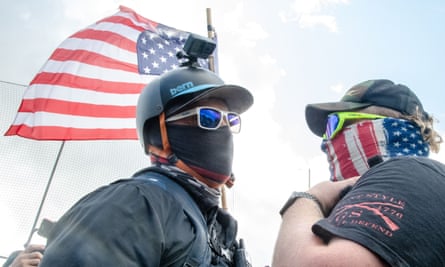Extract from The Guardian
Signalling to his base, as he did referring to the Proud Boys on Tuesday, the president is following a playbook from 1930s Germany.

Last modified on Thu 1 Oct 2020 18.24 AEST
You can imagine the men as they prepared for the showdown. For days, the papers had been predicting a “great sensation”. Press photographers besieged the entrance. No one could enter the building where the debate was due to take place without a special permit. In his dark blue suit, one question above all troubled the party leader, and with the help of his advisers, he puzzled how best to answer it. What if he was accused of links to fascist street gangs?
This wasn’t the United States in September 2020. It was Germany in May 1931.
For as the historian Benjamin Hett describes in his book, Crossing Hitler, the summer of 1931 saw Hitler being summonsed to court and accused of being complicit in the work of gangs who had beaten – and killed – their anti-fascist enemies.
Hitler’s response was to play a double game. First of all, he was worried about looking weak in front of his supporters, who had called him a coward and a conformist. So he needed to signal that the gangs still had his support. Second, he tried to pretend that any harm caused by his supporters was necessary since the country faced a much more threatening enemy: the far left.
“The SA men are the first men in the party,” he told his opponent, the private prosecutor Hans Litten. Then, in answer to Kurt Ohnesorge, the judge who moderated the hearing, Hitler said that the “red murderers” of the left were the real problem: “If an SA man really oversteps the boundary of self-defence, you can’t hold a man responsible for that.”
Compare this to Donald Trump signalling to his base. During Tuesday’s presidential debate, he was asked: “Are you willing tonight to condemn white supremacist and militia groups and to say that they need to stand down and not add to the violence?”
He answered, “I would say almost everything I see is from the left wing, not from the right wing.” He continued: “Proud Boys, stand back and stand by.” Then came the justification: “But I’ll tell you what, somebody’s got to do something about antifa and the left. Because this is not a rightwing problem, this is a leftwing problem.”
Trump is wrong to pretend that the left is responsible for the violence on America’s streets. Between 1 January 1994 and 8 May 2020, white supremacists and other rightwing extremists in the US carried out attacks that left 329 people dead. In the same period, a single attack staged by an anti-fascist resulted in a killing. And during that incident, the one person who lost their life was the anti-fascist perpetrator.
That survey ended in May. Since then, the number of killings carried out by anti-fascists has risen from zero to one. On 29 August this year a pro-Trump truck convoy made its way through Portland, firing paintballs and pepper sprays. A counter-protest saw an associate of the far-right group Patriot Prayer, Aaron J Danielson, shot dead. One anti-fascist, Michael Forest Reinoehl, admitted to the shooting in a media interview, but said he acted in self-defence. He was shot by US marshals on 3 September in Lacey, Washington.
Even after Danielson’s death, the grim headcount remains: the far right has been carrying out killings at the rate of 300 to the anti-fascist one.
The 1920s saw a similar disparity of casualties. The most detailed survey of deaths in Weimar Germany, carried out by the German mathematician Emil Julius Gumbel, found 314 murders carried out by the right in 1918-22 and 15 by the left. After 1923, deaths fell almost to zero before resuming again from 1928 with the rise of the Nazis.
In the US, since 2016 and Trump’s election, attacks on leftwing demonstrators have become more frequent. They have included the killing of anti-fascist protester Heather Heyer at Charlottesville. James Alex Fields Jr drove his car at protesters after being photographed earlier brandishing a shield with a fascist symbol right out of the 1920s (a bundle of rods and an executioner’s rod). He was sentenced to life in prison.
There were the 11 worshippers shot at the Tree of Life synagogue in Pittsburgh, allegedly by Robert Bowers. And there have been the more than 100 white supremacists who have attempted to disperse anti-racist protests since the spring by driving their cars at demonstrators – the same method of attack as that used by Fields at Charlottesville.
Hitler’s followers were responding to the electoral success of the left; they knew that in areas of Berlin the Communist vote was as high as 40%. And, in order to break the opposition to Hitler, they went into those districts and beat and killed antifascists. It was this violence that led to Hitler’s trial.
The main purpose of the Proud Boys, in summer 2020, is the same. That’s why the they were in Portland last weekend, carrying posters denouncing anti-fascists and supporters of Black Lives Matters, and promising to drive the left out of the city.
Trump is lying when he says that the left is responsible for the violence. In blaming the left he is encouraging his armed supporters and inviting further killings.
In many ways Trump is a weak authoritarian. After four years in power, Trump has not gone to war. His opponents are at large and not in jail. But when Trump defends armed gangs, he echoes the worst moments in modern history.
• David Renton is a barrister and author of Fascism: History and Theory
No comments:
Post a Comment